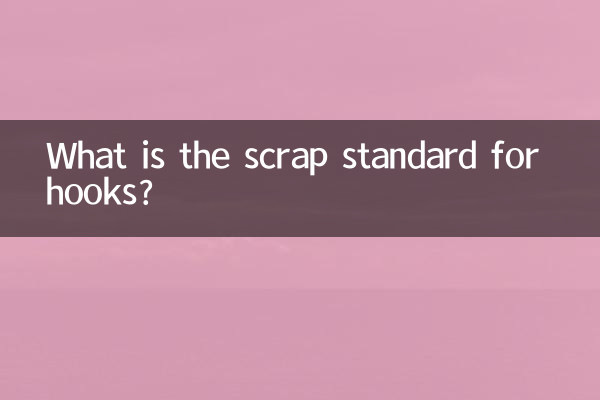What is the scrap standard for hooks?
In industrial production and lifting operations, the hook is an important load-bearing component, and its safety is directly related to the safety of personnel and equipment. In order to ensure the safety of hooks, relevant national departments have formulated strict scrap standards. This article will introduce the scrap standards of hooks in detail and provide structured data to help readers better understand and apply them.
1. Standards for scrapping hooks

The scrapping standards of hooks are mainly judged based on their wear, deformation, cracks and other defects. The following are specific scrap standards:
| Defect type | scrap standards |
|---|---|
| wear and tear | The hook opening increases by more than 15% of the original size |
| deformation | The torsional deformation of the hook exceeds 10 degrees |
| crack | Any visible cracks on the surface of the hook |
| Corrosion | Corrosion depth exceeds 10% of original size |
| wear grooves | The depth of the wear groove exceeds 25% of the diameter of the wire rope |
2. Inspection method of hook
To ensure the safety of the hook, regular inspections are essential. The following are common inspection methods:
| Check items | Check method |
|---|---|
| Appearance inspection | Visually inspect the surface of the hook for cracks, deformation or corrosion |
| Dimensions | Use calipers to measure the opening and wear of the hook |
| Magnetic particle inspection | Conduct magnetic particle inspection on the hook to detect internal cracks |
| Ultrasonic testing | Using ultrasonic waves to detect defects inside hooks |
3. Maintenance and maintenance of hooks
In order to extend the service life of the hook, regular maintenance and upkeep is essential. The following are recommendations for care and maintenance:
| maintenance items | Maintenance method |
|---|---|
| clean | Regularly clean dirt and corrosion on the surface of the hook |
| Lubrication | Lubricate the moving parts of the hook to reduce wear |
| store | Moisture and corrosive environments should be avoided during storage |
| Regular inspection | Conduct professional inspections according to prescribed cycles |
4. Treatment after the hook is scrapped
Once the hook reaches the scrap standard, it must be stopped immediately and properly disposed of. The following are suggestions for handling:
| Processing method | Specific operations |
|---|---|
| destroy | Cut or crush scrap hooks to ensure they cannot be used again |
| Recycle | Send metal parts to professional recycling stations |
| record | Record the number and disposal method of scrapped hooks |
5. Summary
The safe use of hooks is an important link in industrial production. Inspection and maintenance in strict accordance with scrap standards can effectively avoid safety accidents. This article introduces the scrap standards, inspection methods, maintenance and scrap treatment of hooks in detail through structured data, hoping to provide a reference for relevant practitioners.
If you have other questions about the scrapping standards of hooks, it is recommended to consult professional safety technicians or relevant departments to ensure the safety and compliance of operations.

check the details

check the details